Specification
Mixed media H0 scale (1:87) models with sound and HD video (forthcoming). Various dimensions and duration.
Description
Following the temporary end of travel and the order to ‘stay at home’ as a result of the Covid-19 pandemic, a year’s worth of planning for site specific fieldwork (my primary method for work to date) was aborted.
Trying to make sense of how I might engage with space-place and further my work whilst confined to the same room that I ate, slept and worked in, the #fieldworkingfromhome series explores the sites and re-imagined sounds of the field in H0 (1:87) miniature scale.
As our homes became sanctuary from the dangers of the pandemic, what would fieldwork look like within this new normal? What does fieldwork sound like for a fieldwork researcher who has no access to their chosen field?
During the pandemic, the tabletop miniature figurine fantasy wargame company Games Workshop became one of the most successful stories of the stock market. Following the traditions of diorama building, and re-imagining landscapes, both new and old, through scale model making, this project explores the sanctuary of home as place for imaging the field beyond.
H0.1 (Île de Ré)
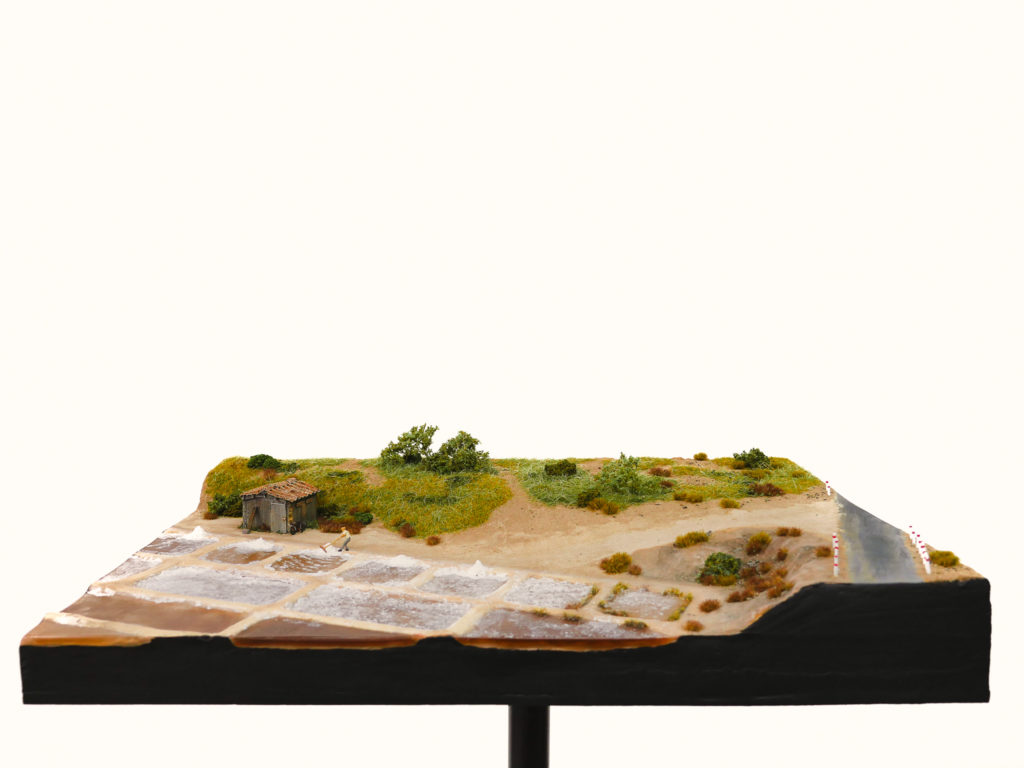
Dimensions: 600x410x170mm
Medium: Teloxys aristata, lichen, potassium sodium tartrate tetrahydrate, birch ply, extruded polystyrene, card, plaster, sand, soil, acrylic, epoxy, balsa.
Description:
During the First World War a French scientist named Paul Langevin began to experiment with an interesting crystal called Rochelle salt (potassium sodium tartrate tetrahydrate). He wired specimens up, placed them underwater and found that they would produce a voltage when a sound in the water was made. A simple salt crystal was demonstrated to have huge piezoelectric potential and became the basis for sonar technology. Piezoelectric crystals such as Rochelle salt and quartz, are to this day critical crystal elements in computing and other electronic technologies, as well as popular within metaphysical, crystal healing and wellness markets. Meanwhile, the Île de Ré, a small island just off the coast of La Rochelle, is a major site for artisanal, high grade sea salt production.
I had been invited by a local salt farmer and museum to produce fieldwork during a short residency on the Île de Ré in 2020 but unfortunately due to the restriction of travel and the ongoing effects of the pandemic it wasn’t possible to attend.
H0.2 (Llyn Llywenan)
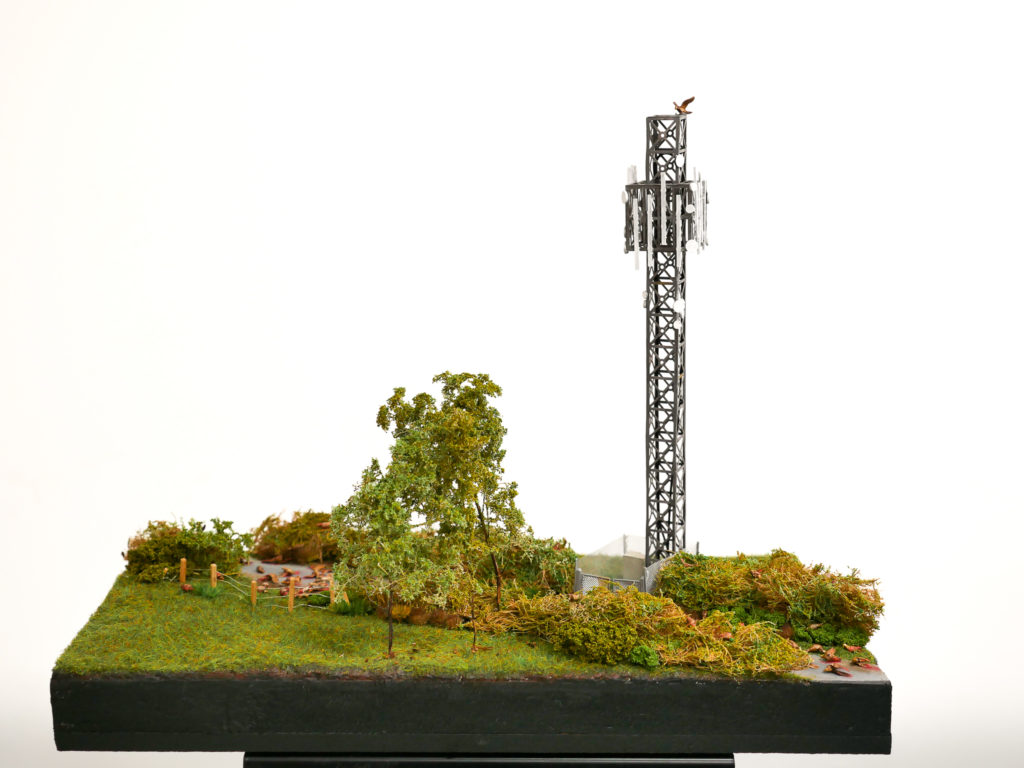
Dimensions: 390x210x320mm
Medium: Teloxys aristata, lichen, coconut fibre, birch ply, extruded polystyrene, card, plaster, sand, soil, acrylic, epoxy, stereo sound and HD video (duration 13min 15sec)
Description:
In December 2019, just before the start of the pandemic, a mass bird death incident occurred on the island of Anglesey, North Wales. Hundreds of Starlings were found mysteriously dead along a small stretch of single track country road a few kilometers outside the town of Bodedern. Video footage and photos taken from a nearby resident reached national news platforms as people asked questions of how and why this happened.
Mass bird death disasters occur surprisingly frequently. Records of such incidents date back to the mid-Victorian period when a series of unexplained incidents occurred in the North East of England. This incident was the first of its kind within the UK since the mass proliferation of social media.
An online movement of alarmed residents shared concern that the installation of a new 5G test bed antenna in nearby Bangor may have had something to do with the incident. The claims were fueled by a global community of anti-electromagnetic radiation / anti-wireless campaigners. Local police, academics and biologists were quick to dampen such claims, stating it was more likely that a birds of prey frightened the murmuration mid-flight.
I planned to visit the space and began researching where it might be with intentions to travel in March 2020 but postponed due to stay-at-home orders placed at the start of the pandemic. Meanwhile, conspiracy theorist communities continued to use the case as an example to demonstrate that 5G was in-part responsible for the spread of Covid-19, resulting in several network engineers being assaulted in the street and a number of mobile telecommunication towers being set alight across the West Midlands and Merseyside areas.
H0.3 (Comfortless Cove)
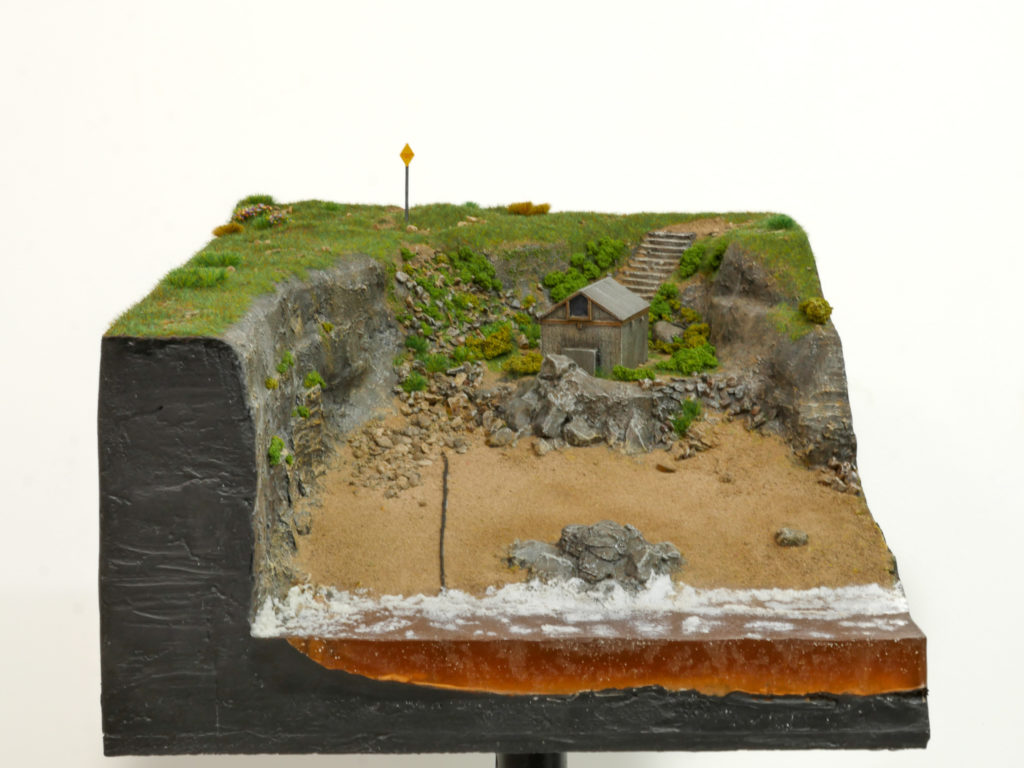
Dimensions: 410x310x170mm
Medium: Teloxys aristata, lichen, birch ply, extruded polystyrene, card, plaster, sand, soil, acrylic, epoxy
Description:
In the late nineteenth century, the remote beach at Porthcurno, Cornwall, became internationally famous as the British termination of early submarine telegraph cables, the first of which was landed in 1870, part of an early international link stretching all the way from the UK to India, which was then a British colony.
In 1872, the Eastern Telegraph Company (ETC) Limited was formed which took over the operation of the cables and built a cable office in Porthcurno valley. The cable hut, where the cable shore ends were connected to their respective landlines, is a listed building and still stands at the top of the beach. In the Inter-War years, the Porthcurno cable office operated as many as 14 cables, for a time becoming the largest submarine cable station in the world, with the capacity to receive and transmit up to two million words a day.
To this day, Porthcurno is a major site for the termination of fibre optic subsea data cable. Over 99% of the world’s internet traffic travels via fibre optic cables even though the average consumer experience of the Internet is almost entirely wireless. During the lockdowns, our homes became our sanctuaries as the country received work from home orders. This was largely possible due to the global subsea fibre optic cable network.
The undersea volcano that erupted near Tonga on 14 January 2022 damaged all fibre optic subsea cables reaching the island, leaving residents disconnected from the outside world. It has highlighted how dependent nations are upon this largely unseen network of 1.3 million kilometres of subsea fibre optic cable.
H0.4 (Zazhoginsky)
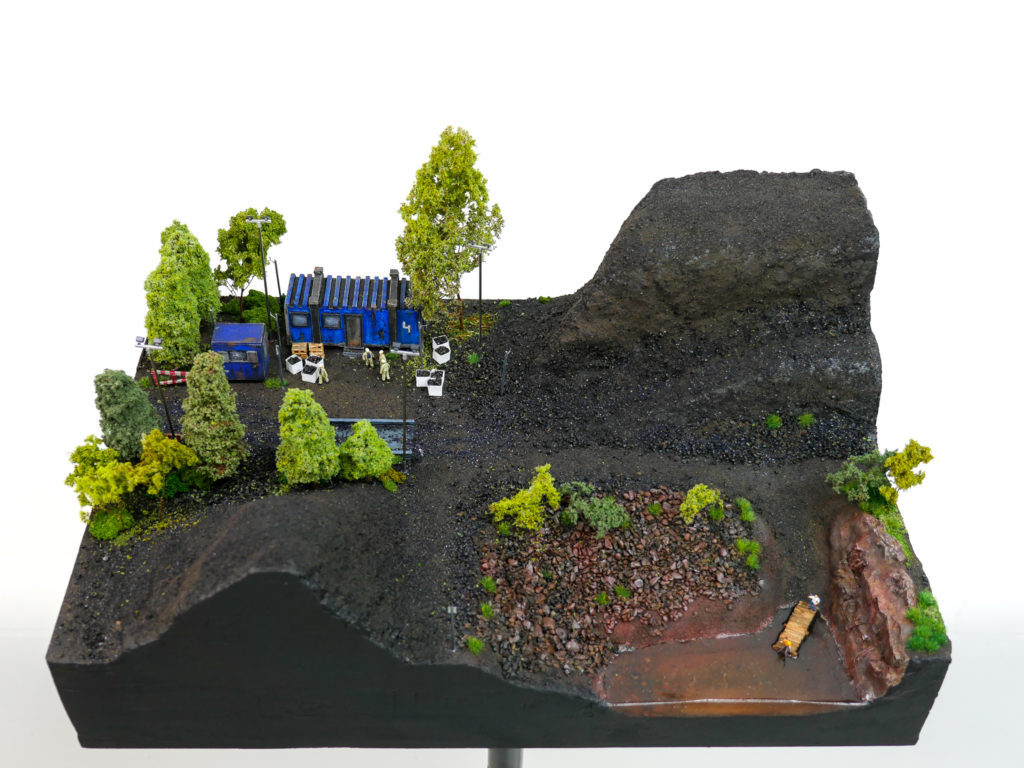
Dimensions: 600x410x240mm
Medium: Teloxys aristata, Birch ply, extruded polystyrene, shungite, card, plaster, sand, soil, acrylic, epoxy, balsa.
Description:
Where do we find sanctuary in times of trouble? Can we find it in our homes? Can we find sanctuary in a necklace, a pendant, a gemstone? In late 2019 I was invited to attend the CEC Back Apartment Residency in St Petersburg, Russia. The residency would take place in June 2020. I had also begun to develop relationships with a team of geologists based in Petrozavodsk, in the northern Russian region of Karelia. Alongside the geologists, I had begun to coordinate a month long project in the field to study the community working to mine, prepare, sell, export and distribute a rare and hyperlocal mineral called shungite.
Shungite has a high carbon content, and is actively used in metallurgy as a substitute for coke in the smelting of iron and steel. However, precisely because of its high carbon content, shungite has become considered by practitioners of crystal healing as a magic stone. Shungite in the past few years has taken the multibillion pound global wellness industry by storm. A particular strength, is its capacity to de-ionize electromagnetic radiation from wireless transmissions (an effect also peer-reviewed by scientists within university research centres). This effect only works effectively when contained within electromagnetically shielded materials. A number of celebrities including Eamonn Holmes (at the time, the UKs highest earning breakfast TV presenter), Calum Best (celebrity son of former footballer), M.I.A. (acclaimed musician), and Harry Kane (Footballer and Captain of the England team) have all endorsed a moratorium on wireless radiation during the pandemic as well as supported the use of electromagnetic shielded ‘wearable anti-tech’ clothing and devices which often claim to use shungite to protect the individual. These items often have high cost and little effect.
H0.5 Tullisaaren puisto
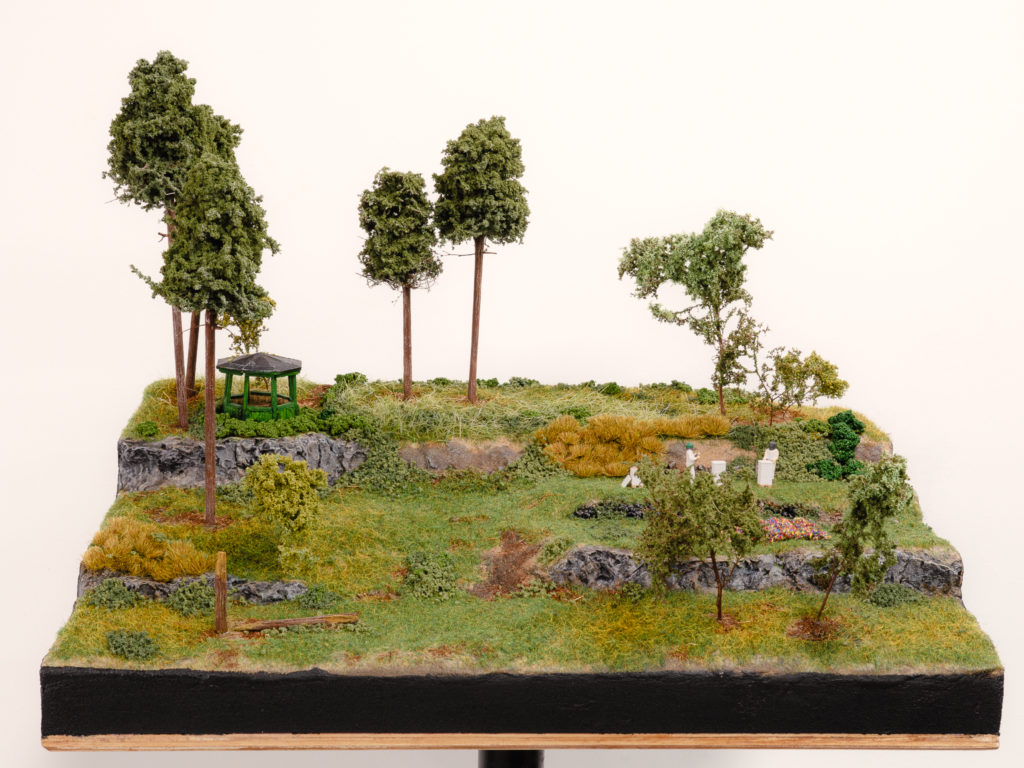
Dimensions: 405x260x140mm
Medium: Teloxys aristata, Birch ply, extruded polystyrene, coconut fibre, card, plaster, sand, soil, acrylic, balsa, mixed fibres, loudspeaker with electronics, lithium rechargeable battery.
Description:
Apis mellifera ligustica is an Italian subspecies of the European honeybee. It is a popular species of bee amongst honey-beekeepers throughout Europe. Many subspecies of bees produce honey to feed themselves. Honeybees are prolific producers of honey. Worker honeybees spend their entire lifespan foraging for pollen and nectar used as the building blocks to feed their colonies, build their homes and care for their young. They eat the honey. Human beekeepers take the honey. They take the bees honey stores for themselves. The honey beekeeper know that they must maintain a fine balance of ecology, between cultivating, caring, and taking.
Honeybees do not have ears. They instead listen to vibrations from the hertzian world through the hairs on their bodies. They navigate complex mappings across their broad habitats, foraging, searching and extracting the pollen and nectar surrendered/offered by plants, throughout the blossom periods. They communicate their findings, the best forage sites, by means of a series of navigation dances or ‘waggle dances’. These dances are thought by some to be a response to the environmental conditions, the topography, but also the invisible (to humans) electromagnetic spectral topography. It has led some to suggest that honeybees – a critically important species for pollination of crops and a key marker of generating biodiversity in ecosystems – are susceptible to alterations in the hertzian space of the electromagnetic realm. As such there are some people concerned that electromagnetic telecommunication technologies such as 5G are a risk to the lives of honeybees across the world, and therefore a huge risk to biodiversity and crops. Some beekeepers have taken to including dustings of the mineral shungite at the entry to their hives so that the bees may collect them onto their bodies through the electroststatic charge their legs and bodies carry.
As a member of the research collective Mehiläisten seura (The Bee Company) I have been exploring remotely, the lifeworlds of bees and asking what can a multidisciplinary artist collective learn from non-human ways of living, working and being creative? When you walk through a park, do you notice the bees? Do you count or record how many honeybees you see? Perhaps how many bumble bees? What does a public park mean to you, and what might it mean to the amateur beekeepers of Tullisaari park, a large public park on the suburban island of Lajasaalo, Finland. Lajasaalo is a suburb of the city of Helisinki, that has been shaped in the western European tradition of the sublime landscape gardens that came to prominence between 1710-1800. It includes cultivated and heavily manicured lawns, winding paths that are mowed frequently and non-native flowers are grown regularly. From a distance, I wonder about the relationships between human beekeepers, our fellow kin, bee humankeepers, and the entanglement between pollination, aestheticism, technology, and cultivation within European park spaces.